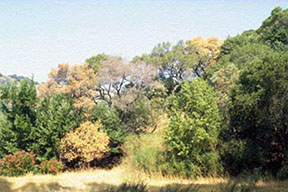Devil Molds

By Botany Bob
Published: April, 2004
“D—!!!! another orchid with black rot,” a cry by orchid afficionados round the world. Black rot is a disease caused by a group of primitive fungi known as water molds. New orchid growths that seem to glow with health,suddenly and without warning are discovered next morning having turned slimy black, and easily come apart emitting a foul, putrid odor that takes repeated scrubbing to remove from the skin. Young and often old leaves easily drop off from shock. The orchidist’s expectations of beautiful and exotic flowers, often after years of diligent care are tragically laid to rest.
A common simple (primative) parasite is frequently responsible, Phytophthora cactorum. If the first name sounds familiar it’s because it belongs to the group responsible for S.O.D.S., Sudden Oak Death Syndrome, receiving much attention in the news media these days. This type of fungus is considered to be simple, (primitive) multiplying at amazing speed and able to exchange genetic material when breeding that results in new forms that can extend their diet to other types of plants and increase their vigor. Higher plants in a state of nature cannot develop defenses as quickly due to fewer offspring and time necessary to reach maturity.
In 1845, Phytophthora infestans, probably brought over on an imported potato from Mexico, ultimately was responsible for the death of well over a million Irish people. The English had taken tithe as their war spoils, and the harvest of all crops and animals, leaving potatoes for the Irish to plant and as the primary food for the Irish population to eat. When the blight hit, potatoes rotted in the ground. The “Potato Famine” instigated mass immigration to the United States of many war- impoverished and near-starving people from Ireland, ultimately enriching our own country.
Leaves of land plants possess openings on the underside referred to as stomata where gaseous exchange takes place. The devilish mold sends microscopic threads through these stomata and sucks the carbohydrate rich food from the cells of the leaves and living parts of the plant. These threads orginating from separate strains of the fungus unite, exchange genetic messages, and ultimately swim by means of flagella (little whips) over a film of water on leaves or soil and infect new plants, soon changing to their rapidly developing sucking threads. Black rot among orchids can be significantly reduced by increasing ventilation between plants (a difficult proposition for the obssessive orchidist who buys more and more), and by buying only disease-resistant plants and giving them the light, temperature, potting media, consistent watering, and reliable minerals they require for health. Though Phytophthora ramorum, the water mold that attacks oaks, is unusual in a number of respects, these fundamentals still apply.
Another common example of the devastation of water molds is “damping off disease.” Damage is evident when seedlings and small plants suddenly wilt and collapse. Things to check:
Never use old potting media for growing new plants.
Be attentive to avoid letting plants stay too wet.
Watch closely in warm weather to avoid stressing by allowing them to go bone dry.
Repot to keep from becoming suffocated as they grow.
Clean out dry dead roots which are a definite boon to water mold infection.
If an infection develops, remove the plant from contact with any other plant
With these tips, it is possible to develop a green thumb.
Botany Bob is Bob Chisari, a horticultural expert who works for Bayside Garden Center located on Tiburon Blvd., just two blocks from the ferry docks in Tiburon. For more information, call (415) 435-0041.

